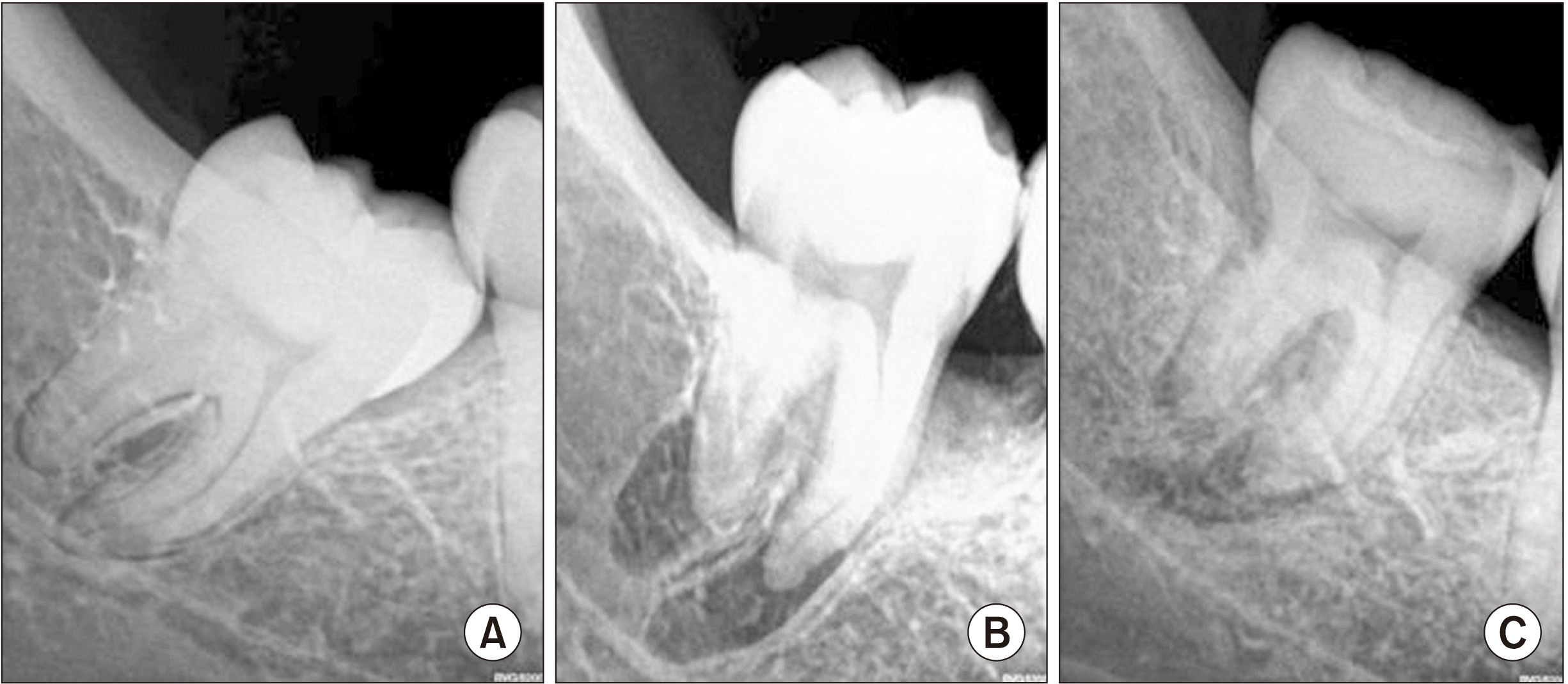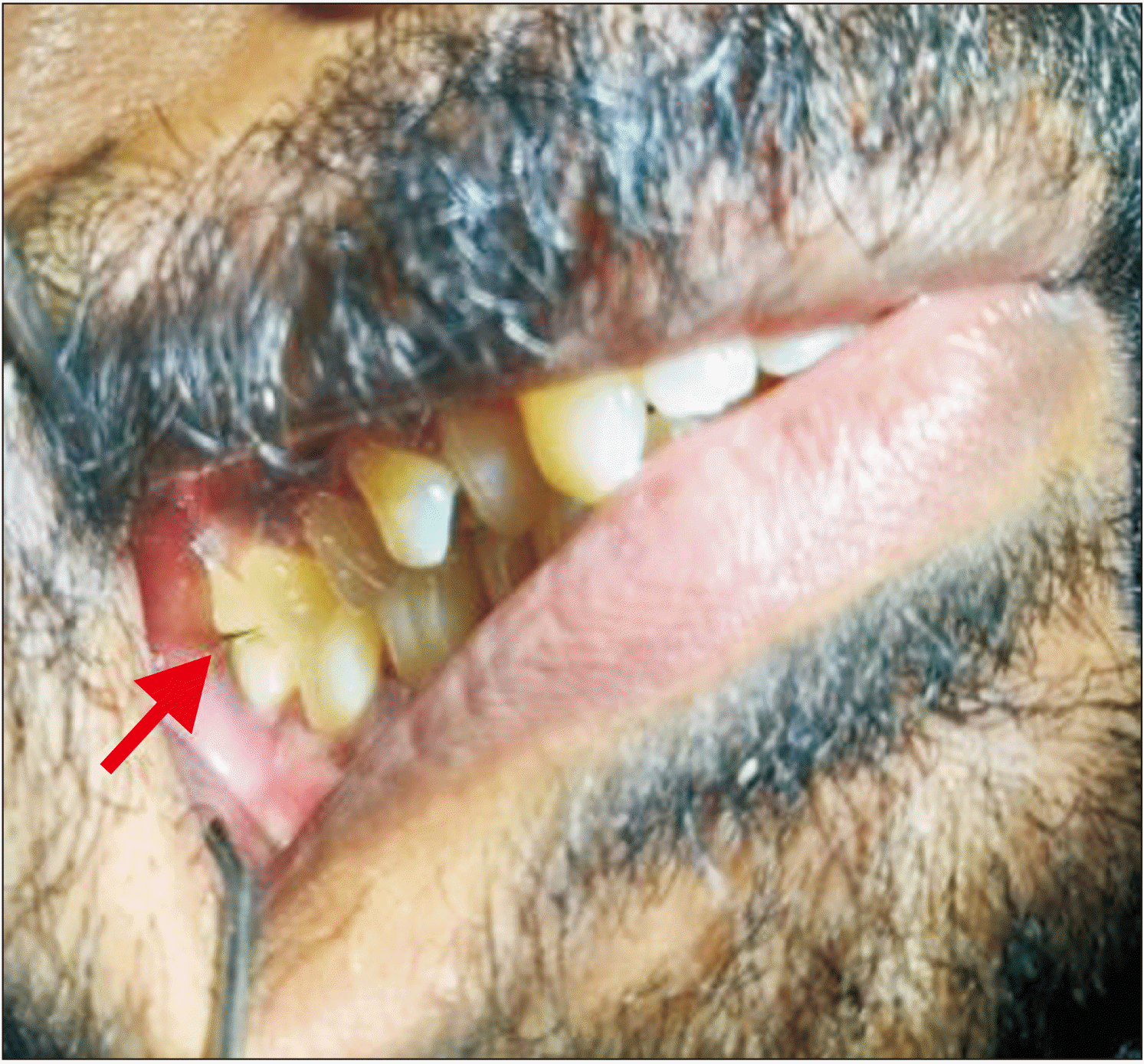Abstract
Impacted mandibular third molar removal is the most common procedure performed by oral and maxillofacial surgeons. An array of alternative procedures have been suggested, like operculectomy in cases of pericoronitis and coronectomy in certain cases. However, these procedures pose several disadvantages, and we propose a relatively non-invasive ‘straight lift technique’. This technique is specifically useful in straightening abnormally positioned mesioangular third molars as a substitute of complete removal. This can improve tooth function, eliminate the need for surgical intervention, and reduce the risk of complications associated with third molar removal.
Removal of an impacted third molar is a frequent procedure in dentistry. The most common reason for removal is recurrent pericoronitis. Food lodgement in the dead space created by an abnormally angled tooth is the main cause for pericoronitis. Less invasive procedures like operculectomy can be done for interim relief. However, removal of the complete tooth is considered the definitive treatment. Despite several advantages of complete removal, there are also various complications in 5% to 30% of cases1, including pain, swelling, nerve injury, restricted mouth opening, dry socket, hematoma, and infection, among others.
In the literature, coronectomy is listed as an alternative to complete surgical extraction. However, this kind of surgical procedure is not helpful in restoring the functionality of the tooth. In some cases, a second surgery is necessary following coronectomy for the removal of roots due to continuous pain, infection, and discomfort2.
Auto-transplantation of an impacted third molar to replace another non-salvageable molar is a well-documented procedure3,4. Using the same concept, impacted third molars can be repositioned in their own socket into a normal anatomical position5. To the best of our knowledge, there have been no studies on this alternative procedure.
We propose a relatively non-invasive ‘straight lift technique’ specifically useful in straightening abnormally positioned mesio-angular third molars as an alternate to complete removal. This can improve the function of the impacted tooth and prevent complications like nerve injury or dry socket.
A 28-year-old male patient visited to outpatient Department of Dentistry, All India Institute of Medical Science, Bhopal, India with the complaint of recurrent food lodgement and pain in the back region of the jaw. On clinical and radiographic examination, a partially impacted mesio-angular, non-carious third molar tooth was observed.(Fig. 1. A) The antagonist maxillary third molar was in the proper functional position. Surgical removal of the entire tooth or crown (coronectomy) was recommended, but the patient refused and asked for alternate management options. Written informed consent was obtained after explaining the treatment plan to the patient.
In this technique, a straight elevator was placed between the second and third molar. Then tooth was positioned in an upright position by gently applying force in an axle and wheel motion under local anesthesia.(Fig. 1. B) The tooth was brought into a cusp and fossa relationship with the upper molar. Mild coronoplasty was performed for further occlusion correction.(Fig. 2) The patient was advised to consume a soft diet for a week. He was prescribed mild anti-inflammatory medications for the next 3 days. Food lodgement complain were resolved completely. At the six-month follow-up, radiographs revealed proper bone healing in the periapical area adjacent to the apex.(Fig. 1. C) In the present case, splinting of the third molar with adjacent teeth was not required. However, surgeons can splint the third molar with adjacent teeth with the help of stainless steel wires or with flexible and passive splints to prevent unwanted shifts in position and facilitate uneventful healing.
Various complications related to the removal of impacted third molars can be avoided by using the straight lift technique8,9. It is a cost-effective method that requires fewer hospital visits in comparison to removal, coronectomy, or operculectomy.
In the present technique, a follow-up period of six months is needed to ensure the technique was successful.
To assess the functionality of the treated tooth, certain prognostic factors should be carefully evaluated such as mobility, occlusion, food lodgement, cheek biting, and root resorption.
The tooth did not require a non-surgical endodontic therapy and was asymptomatic at the six-month follow-up. Coronectomy, on the other hand, can require another surgical intervention, additional appointments, and root canal therapy, leading to increased discomfort in such patients10,11. Operculectomy also requires long-term follow-up and sometimes a second surgery for third molar removal12.
Root resorption due to the change in tooth position remains one of the major complications and undesirable outcomes of this straight lift technique. However, at the 6-month follow-up, minimal root resorption was encountered, the patient was asymptomatic, and the tooth was functional. Occurrence of any of the aforementioned complications indicates the need for extraction.
Within the limitations of our study, the proposed technique is reproducible with an easy learning curve and prevents various complications associated with surgical alternatives such as extraction. However, a prospective clinical trial with a large sample size and long follow-up period is required to evaluate the long-term outcomes of this technique.
Notes
Authors’ Contributions
A.J.R. and J.K. participated in data collection and wrote the manuscript. P.S. and B.L. participated in the study design and helped to draft the manuscript. All authors read and approved the final manuscript.
References
1. Bouloux GF, Steed MB, Perciaccante VJ. 2007; Complications of third molar surgery. Oral Maxillofac Surg Clin North Am. 19:117–28. viihttps://doi.org/10.1016/j.coms.2006.11.013. DOI: 10.1016/j.coms.2006.11.013. PMID: 18088870.

2. Martin A, Perinetti G, Costantinides F, Maglione M. 2015; Coronectomy as a surgical approach to impacted mandibular third molars: a systematic review. Head Face Med. 11:9. https://doi.org/10.1186/s13005-015-0068-7. DOI: 10.1186/s13005-015-0068-7. PMID: 25890111. PMCID: PMC4397866.

3. Ahmed Asif J, Yusuf Noorani T, Khursheed Alam M. 2017; Tooth auto-transplantation: an alternative treatment. Bull Tokyo Dent Coll. 58:41–8. https://doi.org/10.2209/tdcpublication.2016-0011. DOI: 10.2209/tdcpublication.2016-0011. PMID: 28381733.

4. Armstrong L, O'Reilly C, Ahmed B. 2020; Autotransplantation of third molars: a literature review and preliminary protocols. Br Dent J. 228:247–51. https://doi.org/10.1038/s41415-020-1264-9. DOI: 10.1038/s41415-020-1264-9. PMID: 32112013.

5. Dioguardi M, Quarta C, Sovereto D, Troiano G, Melillo M, Di Cosola M, et al. 2021; Autotransplantation of the third molar: a therapeutic alternative to the rehabilitation of a missing tooth: a scoping review. Bioengineering (Basel). 8:120. https://doi.org/10.3390/bioengineering8090120. DOI: 10.3390/bioengineering8090120. PMID: 34562942. PMCID: PMC8468762.

6. Varghese G. Bonanthaya K, Panneerselvam E, Manuel S, Kumar VV, Rai A, editors. 2021. Management of impacted third molars. Oral and maxillofacial surgery for the clinician. Springer;Singapore: p. 299–328. DOI: 10.1007/978-981-15-1346-6_14. PMID: 33994712.

7. Jain A. Bonanthaya K, Panneerselvam E, Manuel S, Kumar VV, Rai A, editors. 2021. Principles and techniques of exodontia. Oral and maxillofacial surgery for the clinician. Springer;Singapore: p. 259–97. DOI: 10.1007/978-981-15-1346-6_13.

8. Rai A, Rai M. 2017; Lingual based four cornered flap for third molar surgery. J Maxillofac Oral Surg. 16:258–9. https://doi.org/10.1007/s12663-016-0909-3. DOI: 10.1007/s12663-016-0909-3. PMID: 28439171. PMCID: PMC5385676.

9. Rai A. Bonanthaya K, Panneerselvam E, Manuel S, Kumar VV, Rai A, editors. 2021. Fractures of the mandible. Oral and maxillofacial surgery for the clinician. Springer;Singapore: p. 1053–84. DOI: 10.1007/978-981-15-1346-6_52.

10. Cosola S, Kim YS, Park YM, Giammarinaro E, Covani U. 2020; Coronectomy of mandibular third molar: four years of follow-up of 130 cases. Medicina (Kaunas). 56:654. https://doi.org/10.3390/medicina56120654. DOI: 10.3390/medicina56120654. PMID: 33261207. PMCID: PMC7760348.

11. Gady J, Fletcher MC. 2013; Coronectomy: indications, outcomes, and description of technique. Atlas Oral Maxillofac Surg Clin North Am. 21:221–6. https://doi.org/10.1016/j.cxom.2013.05.008. DOI: 10.1016/j.cxom.2013.05.008. PMID: 23981497.

12. Abate A, Cavagnetto D, Fama A, Matarese M, Bellincioni F, Assandri F. 2020; Efficacy of operculectomy in the treatment of 145 cases with unerupted second molars: a retrospective case-control study. Dent J (Basel). 8:65. https://doi.org/10.3390/dj8030065. DOI: 10.3390/dj8030065. PMID: 32630221. PMCID: PMC7558131.

Fig. 1
A. Intraoral periapical radiograph showing the partially impacted mesio-angular third molar (preoperative). B. Intraoral periapical radiograph showing the upright third molar with normal occlusion (immediate postoperative). C. Intraoral periapical radiograph showing the healed periapical region in relation to the third molar (at the 6-month follow-up).





 PDF
PDF Citation
Citation Print
Print




 XML Download
XML Download